Discover 35 hidden attractions, cool sights, and unusual things to do in Taganrog (Russia). Don't miss out on these must-see attractions: Alferaki Palace, Birth house of Anton Chekhov, and Chekhov Shop. Also, be sure to include Chekhov Monument in Taganrog in your itinerary.
Below, you can find the list of the most amazing places you should visit in Taganrog (Rostov).
Table of Contents
Alferaki Palace
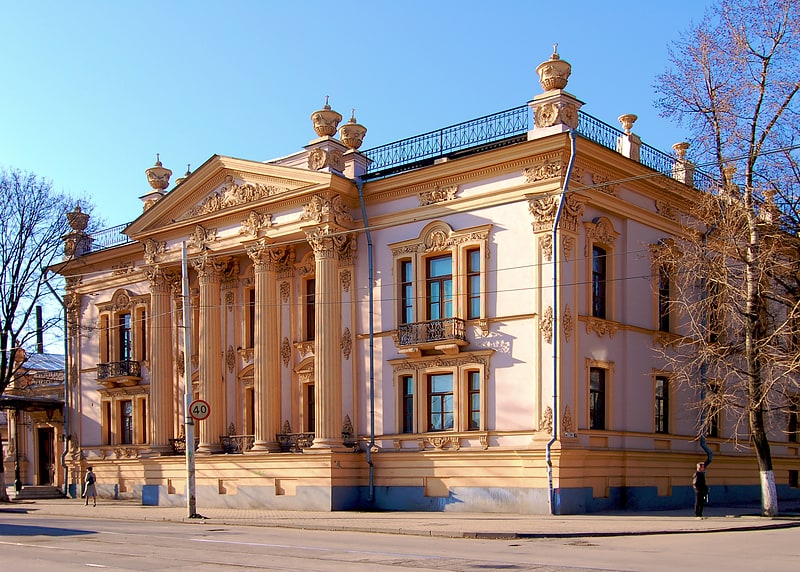
Also known as: Дворец Алфераки
Museum in Taganrog, Russia. Alferaki Palace is a museum in Taganrog, Russia, originally the home of the wealthy merchant Nikolay Alferaki. It was built in 1848 by the architect Andrei Stackenschneider on Frunze Street, in downtown Taganrog.
The building is decorated with a portal featuring four Corinthian columns and stucco moulding in the baroque style. A suite of rooms was created inside, along with a spacious music hall with a ceiling-painting.[1]
Address: Ulitsa Frunze, 41, 347900 Taganrog
Birth house of Anton Chekhov
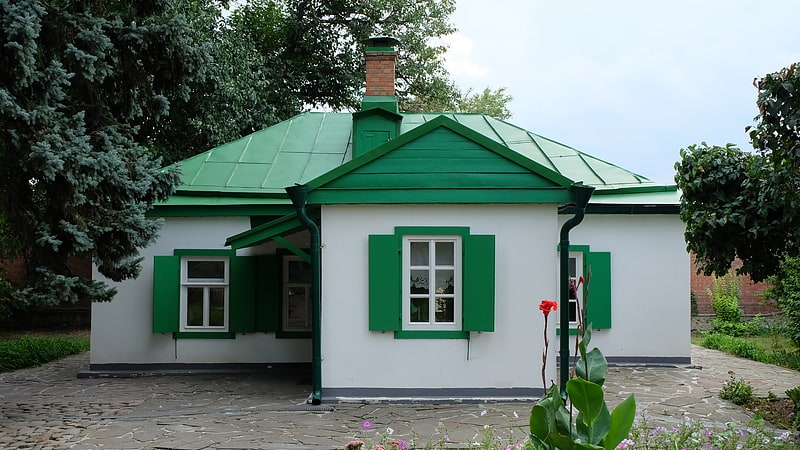
Also known as: Домик Чехова
Museum in Taganrog, Russia. The birthplace of Anton Chekhov is the place in Taganrog, Russia, where the famous writer Anton Chekhov was born. It is now a writer's house museum. The outbuilding on the territory of a property on Chekhov Street in Taganrog was built in 1859 of wattle and daub, plastered and whitened. The area taken up by the small outbuilding is 30.5 sq. meters. The house and grounds were owned by the merchant Gnutov in 1860, and by the petit bourgeois Kovalenko in 1880-1915.
Pavel Yegorovich Chekhov and his family (his wife Yevgeniya Yakovlevna and their two sons—four-year-old Alexander Chekhov and 2-year-old Nikolay Chekhov)—rented the outbuilding in December 1859. Anton Chekhov was born in this house on January 17, 1860. In March, 1861, Pavel Yegorovich Chekhov and his family moved into another apartment.
In 1910, a memorial plate was placed on the house of Chekhov thanks to the initiative of the Chekhov Circle in Taganrog, formed by the writer Yevgeny Garshin in 1905. In 1916, the Taganrog City Council supported the initiative of the Chekhov Circle and acquired the house and grounds on Chekhov Street 69 to conserve the house of Anton Chekhov. In December 1920, the house was freed from all tenants, and a renovation followed in 1921. In 1924, the first exhibition telling of the writer's youth was opened.
In 1935 Maria Chekhova and Olga Knipper came to visit the home city of Chekhov, Taganrog, to participate at the events commemorating the 75th anniversary of Anton Chekhov's birth. Within the framework of the visit, Maria Chekhova presented to the Taganrog memorial museum several Anton Chekhov or Chekhov family memorabilia from White Dacha in Yalta.
As part of the celebrations marking the 150th anniversary of Chekhov's birth, Russian President Dmitri Medvedev visited the House memorial museum on January 29, 2010.[2]
Address: Chekhova st., 69, 347900 Taganrog
Chekhov Shop
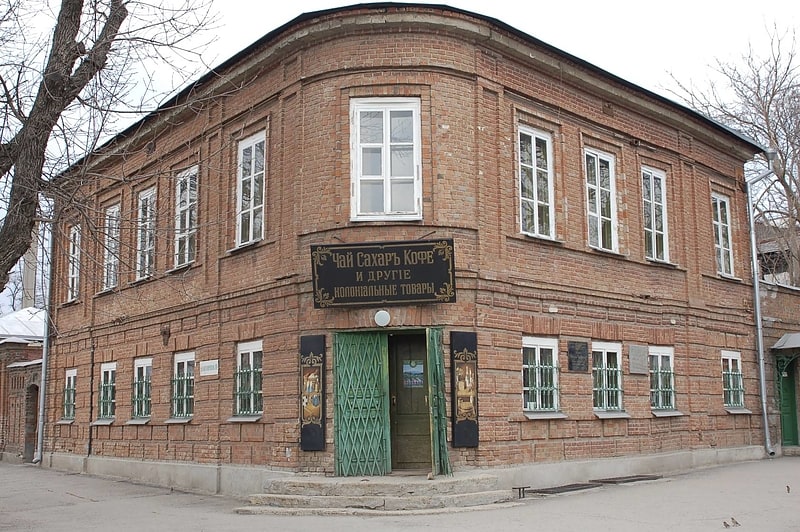
Also known as: Лавка Чеховых
Museum in Taganrog, Russia. The Chekhov Shop is a museum in Taganrog, Russia. This is a two-storey house where the famous Russian writer Anton Chekhov stayed with his family from 1869 to 1874.
The building was built in late 1840s and is located on the crossing of Alexandrovskaya (formerly Monastirskaya Street) and Gogol Street (formerly Yarmarochniy Pereulok). The Chekhov family rented this building from the merchant Ivan Moiseev. The family moved into this building due to commercial interests of Anton Chekhov’s father. The shop’s entry featured a sign "Tea, sugar, coffee, and other colonial goods".
When Anton’s father was away on business, he had to replace him serving as shop assistant and keeping the accounting records. It is on the first floor of this house that the future world-famous playwright wrote his first stories and staged amateur theatricals with other Chekhov family children or with gymnasium fellow students.
November 3, 1977 museum "The Chekhov Shop" was open offering visitors objects and documents related to Chekhov youth years and life of the Chekhov family.[3]
Address: Sverdlova ul., d. 100, 347900 Taganrog
Chekhov Monument in Taganrog
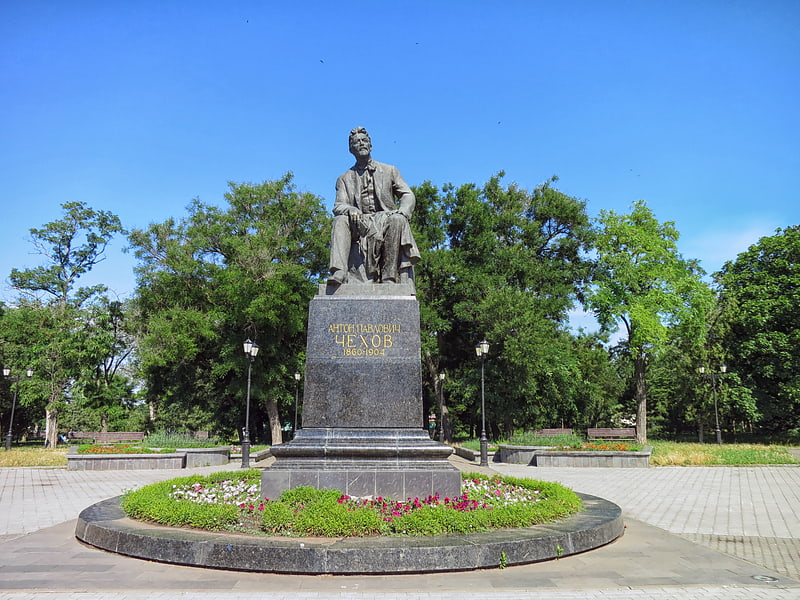
Also known as: Памятник А. П. Чехову
Sculpture by Iulian Rukavishnikov. The Chekov Monument, designed by G.A. Zakharov, sculpted by Iulian Rukavishnikov. Located in the Chekhov Square in Taganrog. It was unveiled on January 29, 1960, to coincide with the writer Anton Chekhov's centennial birth anniversary.[4]
Taganrog military museum
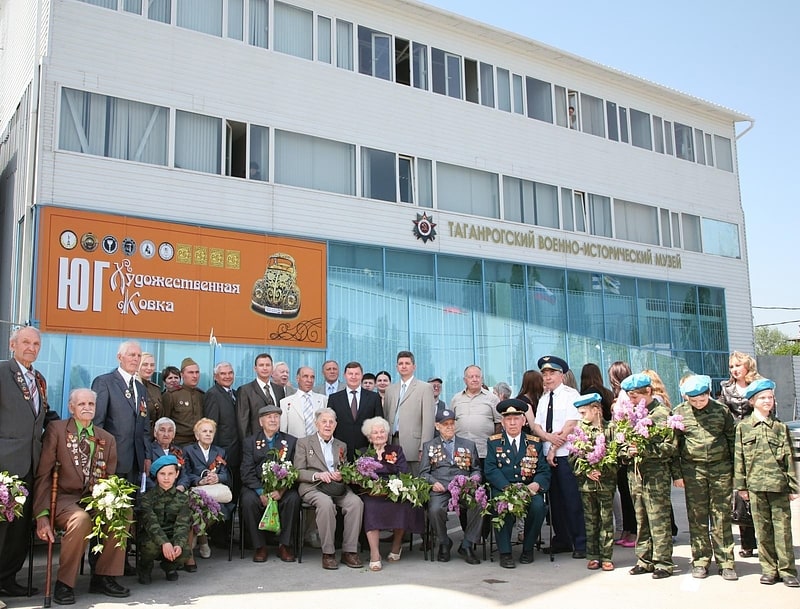
Also known as: Таганрогский военно-исторический музей
Museum in Taganrog, Russia. Taganrog Military Museum is the first private military museum in the Russian city of Taganrog. Its exhibits includes displays of military vehicles and weapons.[5]
St. Nicholas Church

Also known as: Церковь Николая Чудотворца
Church in Taganrog, Russia. The Saint Nicholas the Wonderworker Church is a Russian Orthodox Church in the city of Taganrog in Rostov Oblast, Russia.[6]
Address: 28 улица Шевченко, Taganrog
Peter I Monument in Taganrog
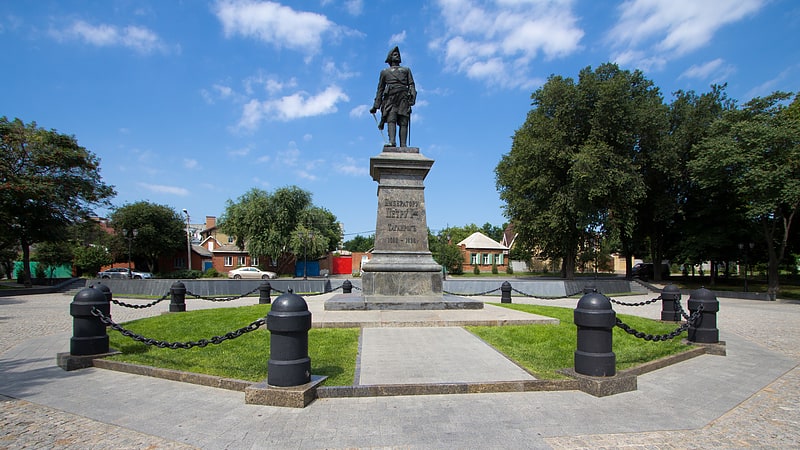
Also known as: Памятник Петру I
Statue by Mark Antokolsky. The Peter I Monument, also known as the Peter the Great Monument, is a monument to Peter I of Russia located in Taganrog, Russia. It is a bronze statue created by the sculptor Mark Antokolsky and first installed in 1903.[7]
Address: Комсомольский сквер, Taganrog
Gorky Park
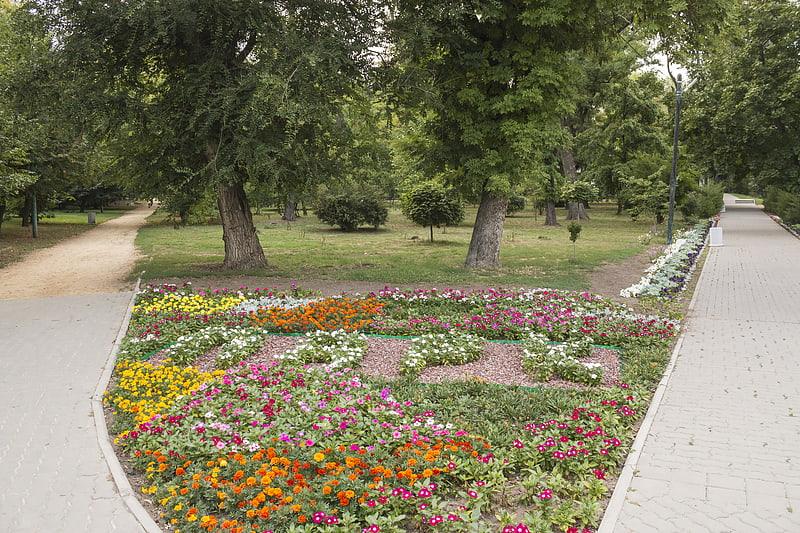
Also known as: Парк культуры и отдыха имени Горького
Park with play areas and shaded seating. The Gorky Park is a municipal park of culture and recreation in the city of Taganrog, Russia.[8]
Address: Petrovskaya st., 104, 347900 Taganrog
Ranevskaya Monument
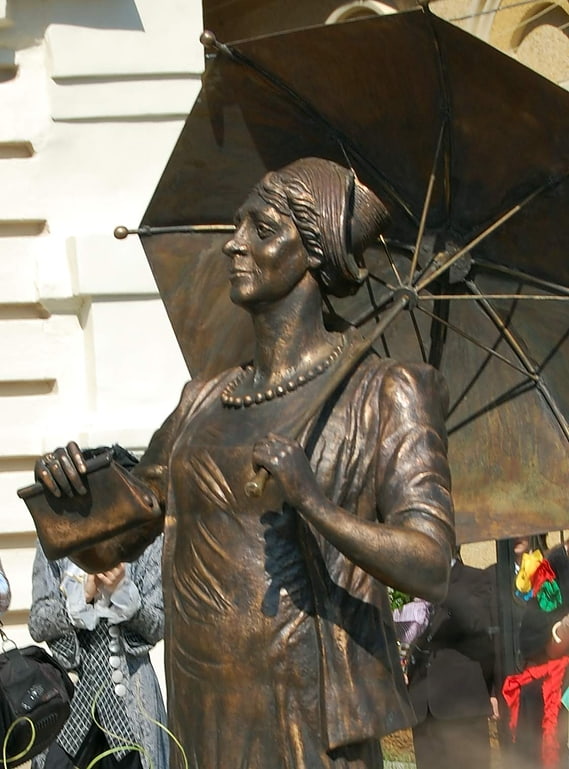
Also known as: Памятник Фаине Раневской
Monument in Taganrog, Russia. The Monument to Faina Ranevskaya, designed and sculpted by David Begalov is located in front of Faina Ranevskaya's birth house in Taganrog, Russia.
Faina Ranevskaya (1896-1984) is recognized as one of the greatest comic actors of the 20th century. She was born on August 27 (August 15 - Old Style), 1896 in the city of Taganrog in the Nikolaevskaya street, 12 (now Frunze Street, 10).
August 29, 1986, a memorial plate dedicated to Ranevskaya was placed on her birth house in the city of Taganrog. Taganrog Local Government is planning to open a museum dedicated to Ranevskaya in the near future. A monument to Faina Ranevskaya (by the artist David Begalov) in front of the house was unveiled on May 16, 2008 within the framework of the First International Ranevskaya Drama Festival "The Great Province".[9]
Address: Таганрог, улица Фрунзе, 10, Taganrog
Taganrog Theatre
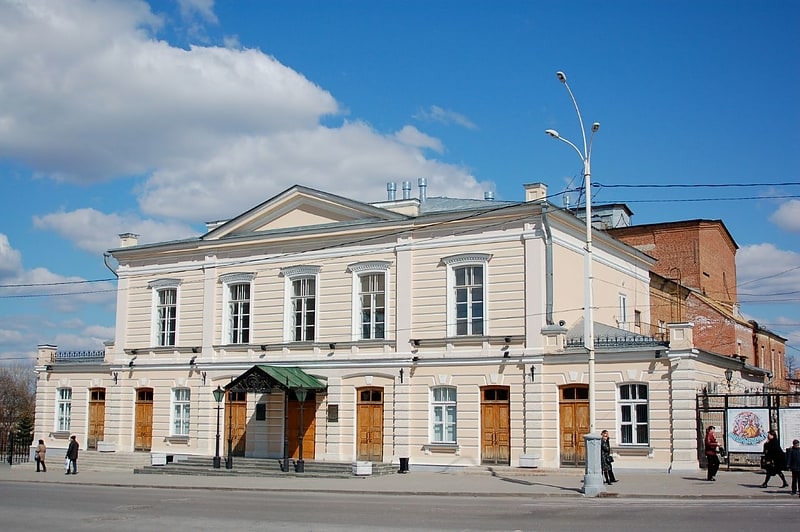
Also known as: Таганрогский драматический театр имени А. П. Чехова
Theater in Taganrog, Russia. The Taganrog Drama Theater named after Anton Chekhov and decorated with Order of Honor is a traditional Russian drama theater based in Taganrog, Rostov Oblast.[10]
Address: Taganrog, Ulitsa Petrovskaya 90
Taganrog Old Cemetery
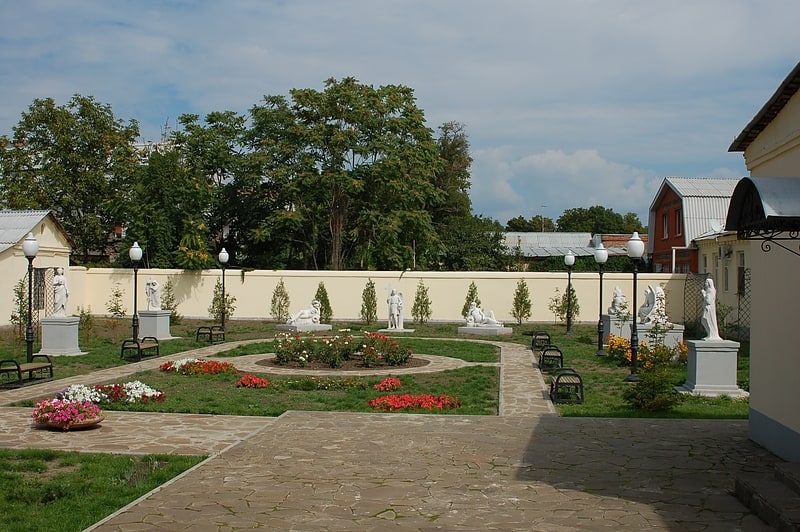
Also known as: Старое городское кладбище
Cemetery in Taganrog, Russia. The Taganrog Old Cemetery is a historic cemetery on the outskirts of Taganrog's historical downtown district that was closed for new burials in 1971.[11]
The Durov Museum

The Durov Museum is a circus art museum dedicated to the famous trainer, artist, one of the most famous representatives of the circus dynasty of Durov, Anatoly Anatolyevich Durov. It is located in Taganrog, Rostov region. It is part of the Taganrog State Literary and Historical-Architectural Museum-Reserve.[12]
Alexander I Palace

Also known as: Дом градоначальника
Mansion in Russia. Alexander I Palace in Taganrog is a one-story stone building in Russian classicism style on Grecheskaya Street, 40 where Russian emperor Alexander I died in 1825.
The mansion was built in 1806 and belonged to different owners. The most significant of them was the Governor of Taganrog Pyotr Papkov. Emperor Alexander I of Russia stayed there twice – in 1818 and 1825. After his death the building was bought by his widow empress consort Elizabeth Alexeievna and the first memorial museum in Russia dedicated to the Emperor was established there. Among the visitors to the palace of Alexander I were the Russian emperors Alexander II of Russia and Alexander III, poets Alexander Pushkin and Vasily Zhukovsky, artist Ivan Aivazovsky, People’s commissar of enlightenment Anatoly Lunacharsky, and many others.
For 12 years beginning in 1864 an amateur choir conducted by Pavel Chekhov sang in the Church of Exaltation of the Cross, which was established within the mansion to honor the emperor. At the end of 1860s – beginning of 1870s Alexander, Nicolas and Anton Chekhov sang there in choral parts of descant and alto. In 1928 the memorial museum was closed and some of the exhibits were moved into the Alferaki Palace.
The building of the Palace of Alexander I houses a children’s sanatorium called “Beryozka”.[13]
Fat and Thin
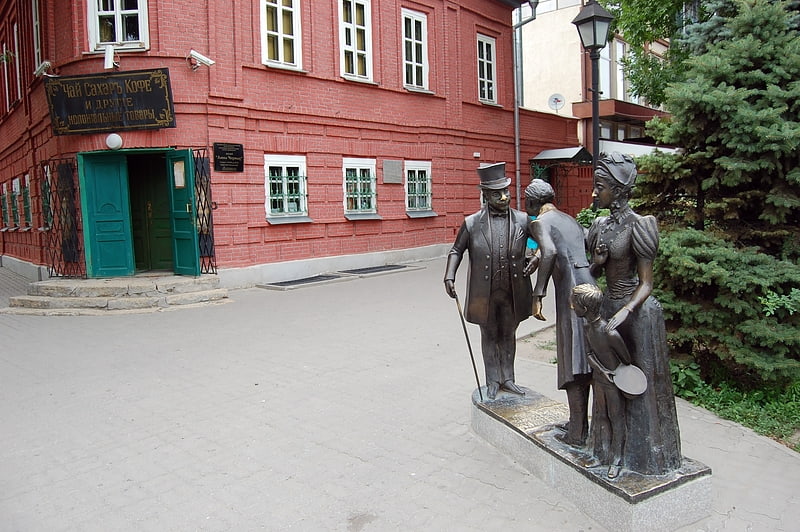
The sculptural composition Fat and Thin is a monument in Taganrog town of the Rostov Region that is illustrating the characters of a satirical short story by Anton Chekhov “Fat and Thin”. The monument was constructed in 2010. Its author is sculptor David Begalov.[14]
Idelson Pharmacy
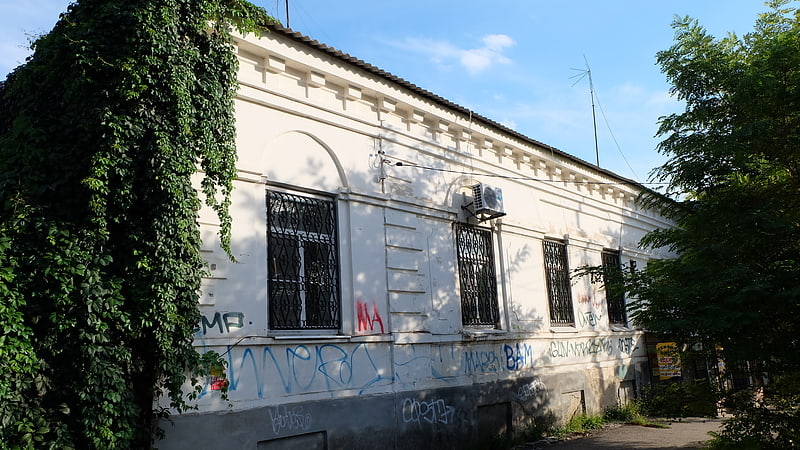
The Idelson Pharmacy is a landmark in the city of Taganrog, Rostov Region, Russia, located in Krasny Pereulok 23. The modern name is Pharmacy No.53. According to Decision No.301 of 18 November 1992, the house where Idelson's pharmacy was located recognized as an object of the cultural heritage of the regional values.[15]
Museum of I.D. Vasilenko
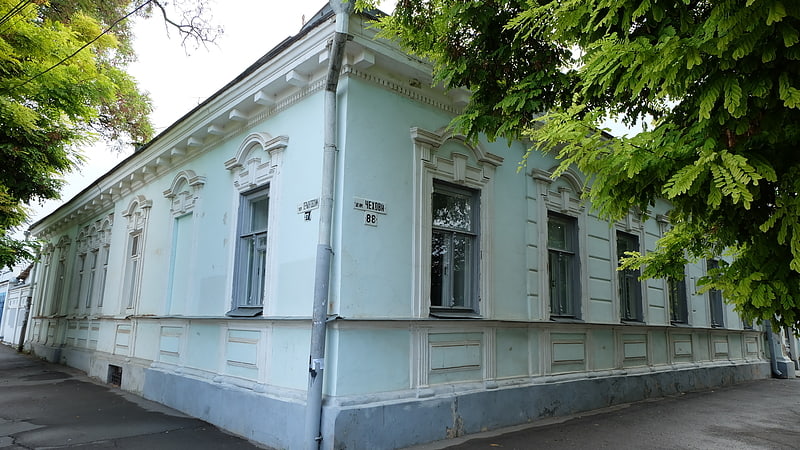
Museum of I.D. Vasilenko is a museum in Taganrog, Rostov region, located in a house in which from 1923 to 1966 lived writer Ivan Dmitrievich Vasilenko, winner of the Stalin Prize. It is the part of the Taganrog State Literary and Historical-Architectural Museum-Reserve. It is located at Chekhov street, 88.[16]
Sculptural composition "Egyptian Pyramid"

The sculptural composition "Egyptian Pyramid" is a sculptural composition in Taganrog created by sculptor Dmitry Lyndin based on the story of Anton Chekhov "Kashtanka".[17]
Peter barracks
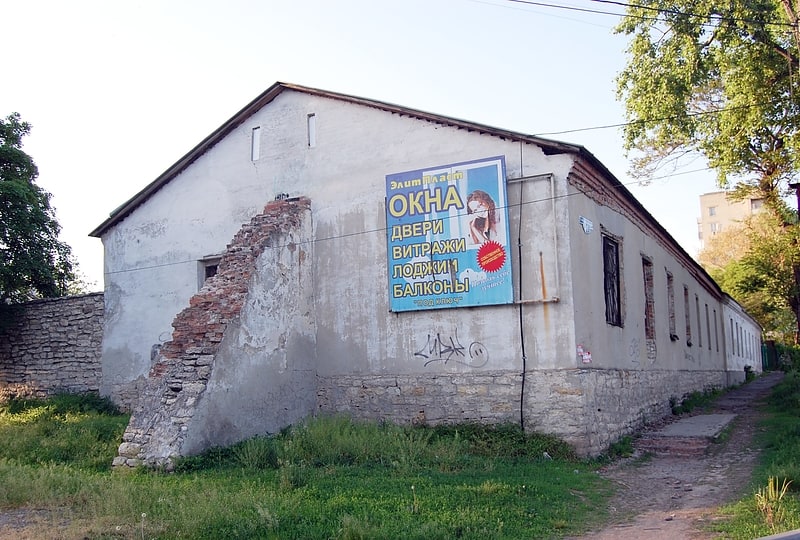
Also known as: Петровские казармы
Peter barracks — a historical monument in Taganrog, Russia, that was built at the end of the 18th century. Is a part of «combined arms cell» of Taganrog Fortress. It is also a valuable object of cultural heritage of federal importance.[18]
House of teacher
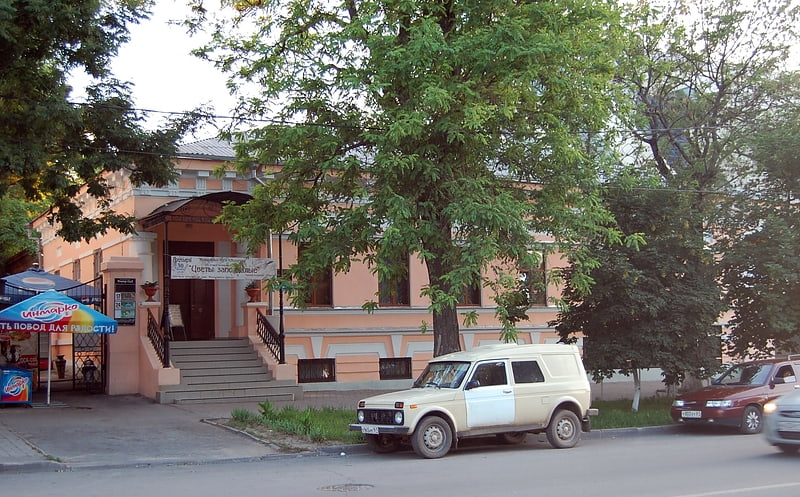
The House of teacher is an ancient mansion in the central part of Taganrog.[19]
Address: 89 Петровская улица, Taganrog
Chapel of Saint Pavel of Taganrog
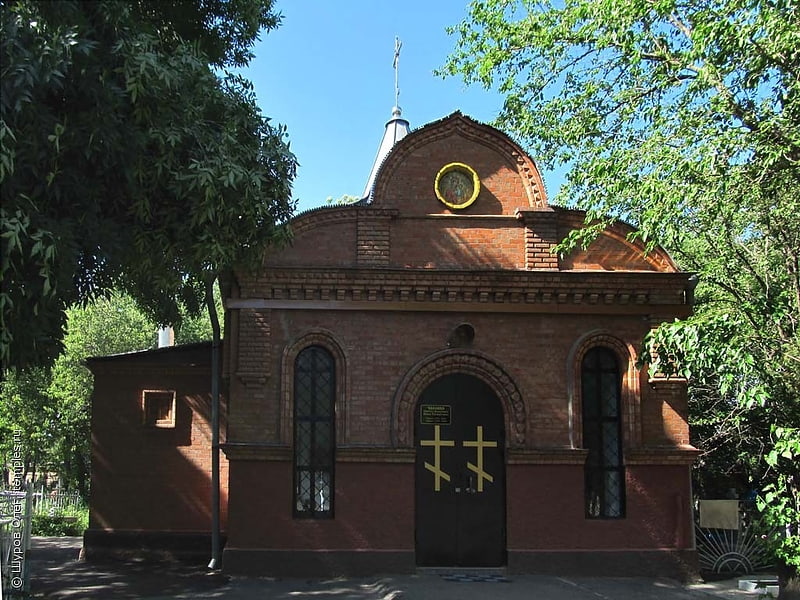
Place of worship in Taganrog, Russia. The Chapel of Saint Pavel of Taganrog is a place of worship, which is located at Street Lagerny, 2, in Taganrog, Rostov Region. The chapel was first erected in 1905 at the burial place of Pavel Pavlovich Stozhkov. The religious denomination of the chapel is orthodox.[20]
Taganrog Museum of Architecture and Urbanism
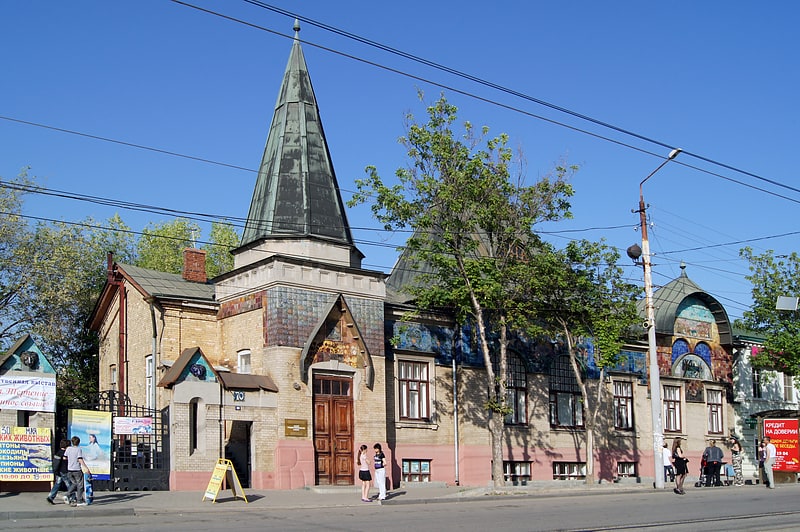
Also known as: Музей градостроительства и быта
Museum. Taganrog Museum of Architecture and Urbanism is a museum in the city of Taganrog, Russia. The building was designed by the architect Fyodor Schechtel's studio.[21]
Address: Frunze st., 80, 347900 Taganrog
Taganrog Round House
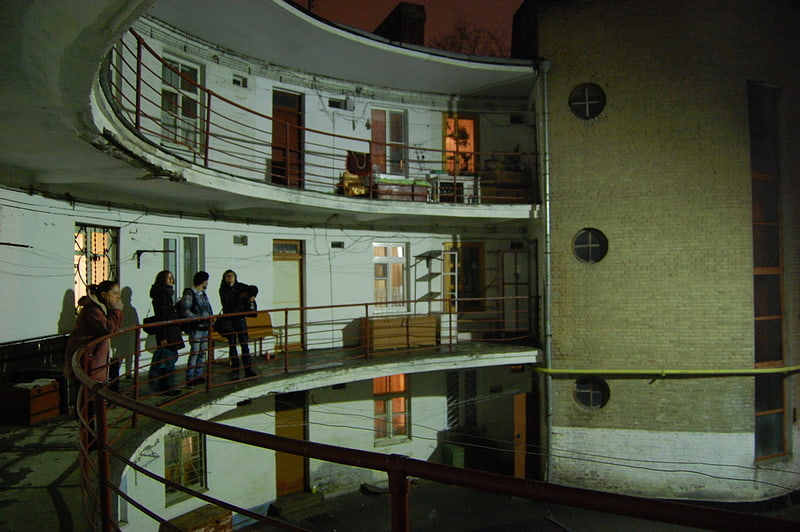
The Taganrog Round House is a residential apartment building in Taganrog, and was the first round house built in the USSR. It is located at 107 Aleksandrovskaya St.[22]
Chernoyarova House
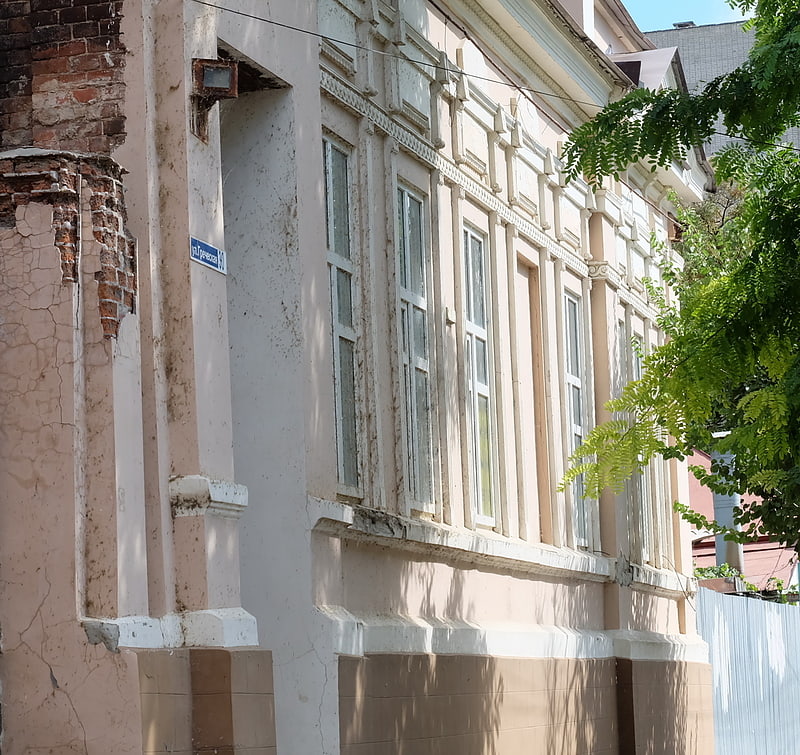
Chernoyarova House is an old mansion in Taganrog, built in the second half of the 19th century. It is officially declared as an object of cultural heritage of Russia of Regional importance.[23]
Third Bastion of the Trinity Fortress Monument
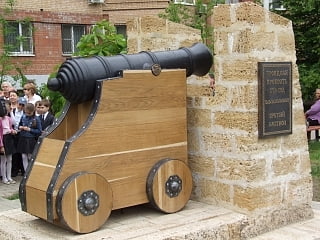
Monument "The Third Bastion of the Trinity Fortress" is a monument that was installed in 2015 in Str. Petrovskaya, 15 in Taganrog, Rostov Region, Russia to commemorate the location of the city's historical Trinity Fortress.[24]
Alexandrovskaya Square

Alexandrovskaya Square is a city square of Taganrog.[25]
Chekhov Gymnasium
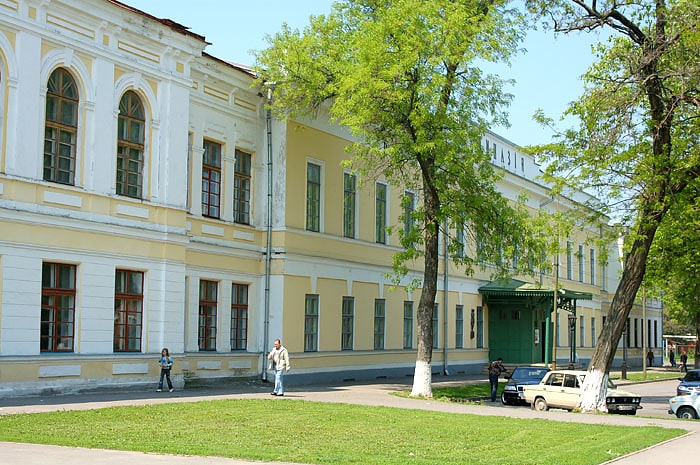
Also known as: Гимназия № 2 имени А. П. Чехова
Gymnasium. The Chekhov Gymnasium in Taganrog on Ulitsa Oktyabrskaya 9 is the oldest gymnasium in the South of Russia. Playwright and short-story writer Anton Chekhov spent 11 years in the school, which was later named after him and transformed into a literary museum. Visitors can see Anton's desk and his classroom, the assembly hall and even the punishment cell which he sometimes visited.[26]
House of Sirotinykh
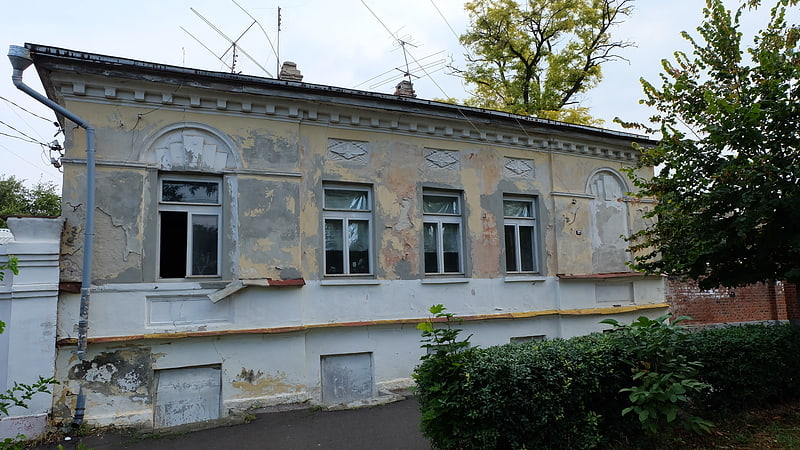
The House of Sirotinykh is an object of cultural heritage in the street Chekhova, 82 in the city of Taganrog of the Rostov Oblast. Belongs to the category of monuments of architecture.[27]
House of Tsysarenko
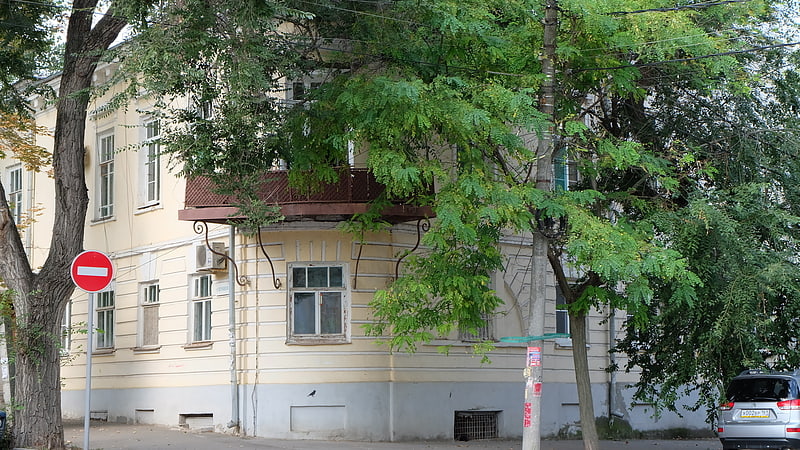
Tourist attraction in Taganrog, Russia. The House of Tsysarenko is an object of cultural heritage of regional value constructed at the beginning of the 19th century down the street Greek, 55 in the city of Taganrog of the Rostov Oblast. The house has historical value as the place which was visited by the writer Anton Pavlovich Chekhov.[28]
House of Lukin
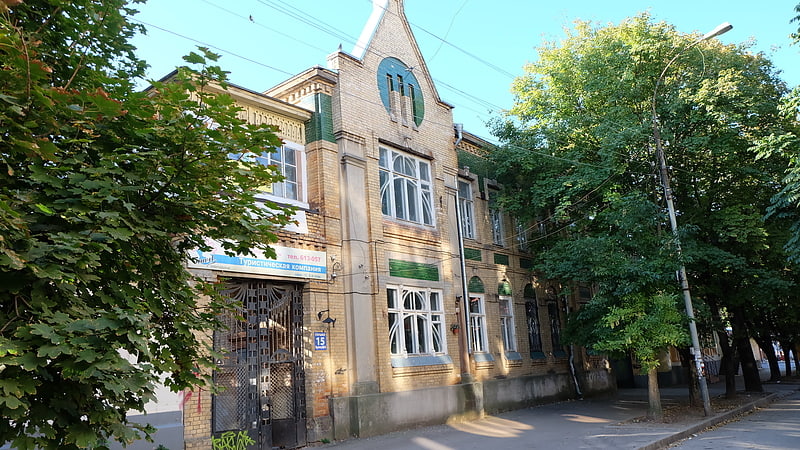
The House of Lukin is a monument of architecture of local value which settles down in Anton Glushko Lane, 15 in the city of Taganrog of the Rostov Oblast.[29]
Tchaikovsky House in Taganrog
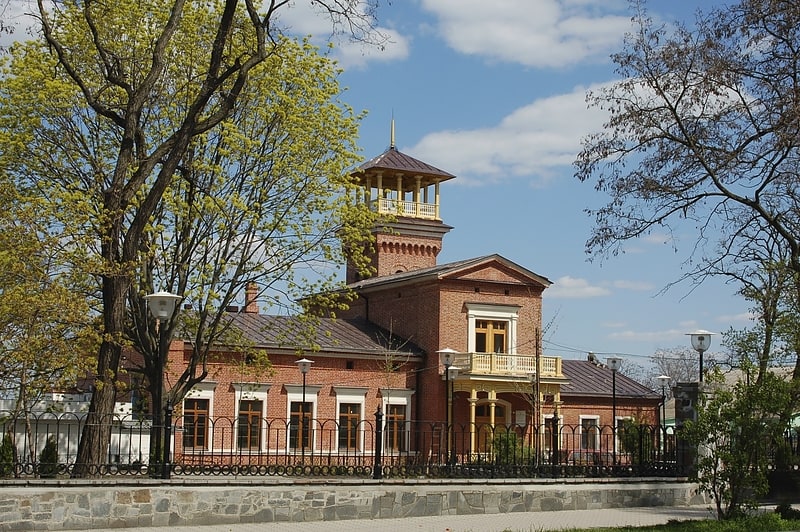
Also known as: Дом Чайковского
The Tchaikovsky House in Taganrog is a historical mansion in the historical downtown Taganrog on Ulitsa Grecheskaya, 56. The mansion was built in early 1870s by the project of the architect Petrov. It was owned by the merchant Sarandino until mid-1890s.
From 1883 until 1894, the building was rented by the captain of the first rank Ippolit Tchaikovsky who served in Taganrog representing the Russian Society of navigation and trade. Pyotr Tchaikovsky came to Taganrog and stayed at this house three times: in 1886, 1888 and in 1890.
The building was mentioned in one of Anton Chekhov's letters to his cousin Georgy Chekhov in 1895:
If I were rich, I would certainly buy the house where Ippolit Tchaikovsky used to live.
The mansion was damaged during the 1927 Crimean earthquakes and as consequence, the left wing was demolished.
In 1975 the music department of the Chekhov Library and the concert hall moved into the building. A memorial room, where Pyotr Tchaikovsky stayed was transformed into a small museum dedicated to Tchaikovsky family and their relations with Anton Chekhov. The museum was inaugurated on May 1, 1976.
In 2009-2010 started a major renovation of the building, which was aimed at reconstruction of the original design the way it was in late 19th century, thus removing the weather vane which was placed around 1976/1977 and which was too heavy for the old building.[30]
Address: 56Б Греческая улица, Taganrog
Taganrog Museum of Art
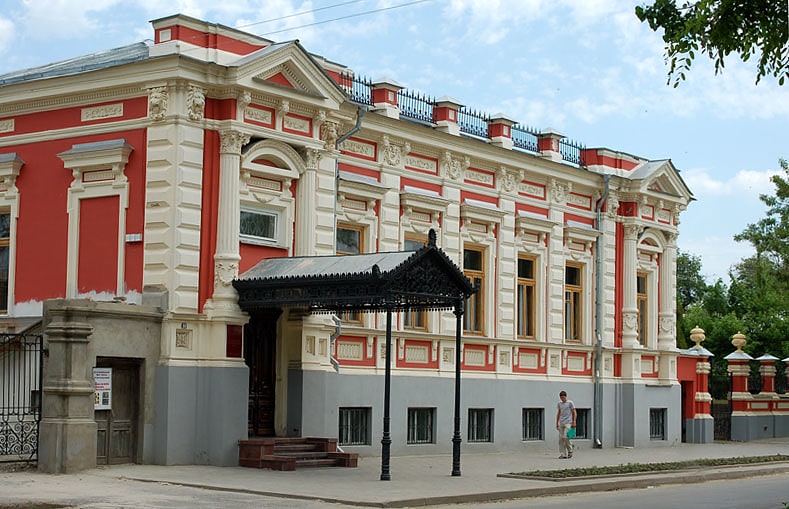
Also known as: Таганрогский художественный музей
Museum in Taganrog, Russia. Taganrog Museum of Art was officially inaugurated in 1968, but the basis of the museum collection was formed by the end of the 19th century, when the art department of the Taganrog's city museum was established.
Renowned playwright and short-story writer Anton Chekhov played a major role in establishing the collection of his home city through his connections in St. Petersburg Academy of Arts and his friends like Mark Antokolski etc.
The most important part of the museum collection was formed in the Soviet Union time, and features two departments - Russian art before the Russian Revolution of 1917 and Soviet art.
The whole collection of art was looted from the museum during the Occupation of Taganrog in 1941–1943.
Since 1975, the museum of art is located at the former mansion of merchant Anton Handrin on Alexandrovskaya street 56.[31]
House of Averino
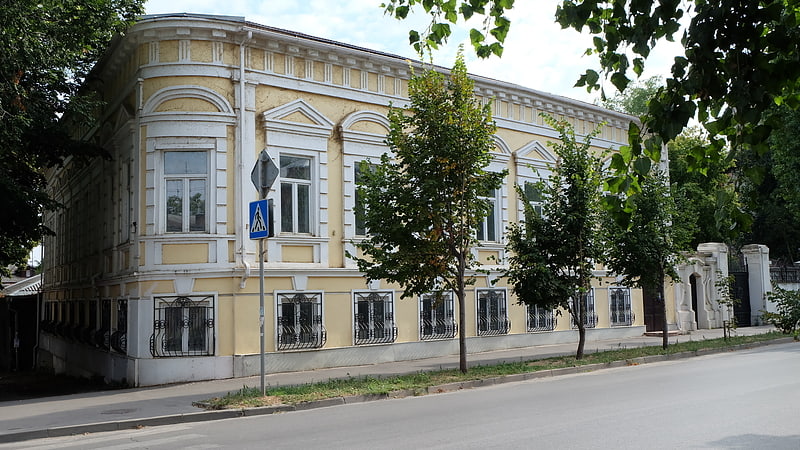
The House of Averino is a mansion of the middle of the 19th century in the historic center of Taganrog located at the address by Grecheskaya Street, 50. As a part of a historical building of Grecheskaya Street Averyino's house is included in the list of objects of cultural heritage of regional value.[32]
Depaldo Stairs
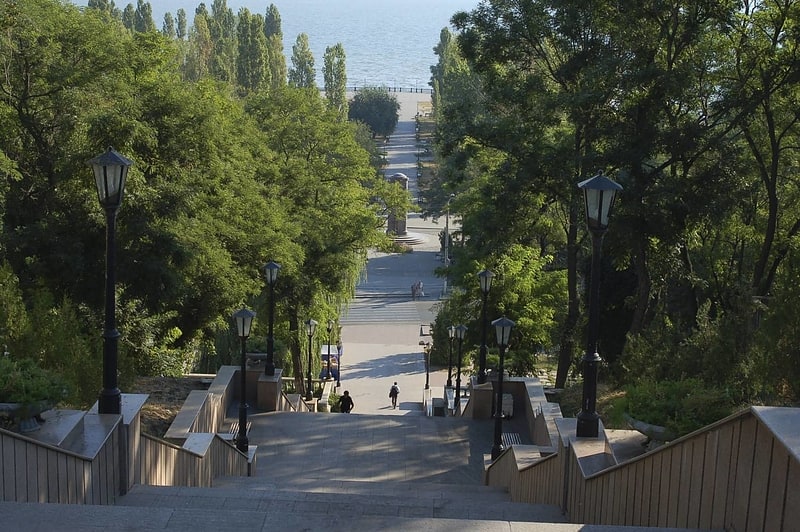
Also known as: Каменная лестница
Historical landmark in Taganrog, Russia. The Depaldo Stone Steps in Taganrog in Russia were constructed in 1823. They were the project of the Italian architect Francesco Boffo, with the funding of Taganrog's Greek merchant Gerasim Depaldo, at the crossroads of Greek Street and Depaldo Street in Taganrog. The stairway begins up on the hill in downtown and goes down ending near the Sea of Azov foreshore.
In Imperial Russia they were the famous stairs in South Russia, similar to the Potemkin Stairs in Odessa.
In World War II, the Old Stone Steps were heavily damaged, but stayed one of the major tourist attractions of Taganrog. In the 1970s they were reconstructed, but not finished. The new major reconstruction was made in 2005. During the latest reconstruction all the old stone steps were replaced by new stones.
At the top of the steps on Grecheskaya Street stands a sundial (1833).
One of the short stories written by Soviet Russian Ivan Vasilenko titled Sundial (Russian: Солнечные часы) was dedicated to the sundial near the Old Stone Steps.[33]
Garibaldi Monument in Taganrog
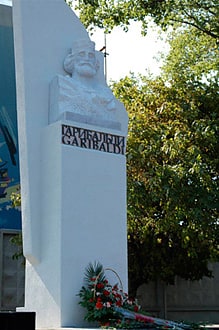
Also known as: Памятник Гарибальди
Sculpture created in 1961. A monument of Italian general and nationalist Giuseppe Garibaldi, one of the leaders of Italian unification, is located in Taganrog, one of the largest ports in Russia. Built in 1961, the monument commemorates Garibaldi’s visit to Taganrog in April 1833, and it celebrates the friendship between Italy and Russia.[34]
Chekhov Library
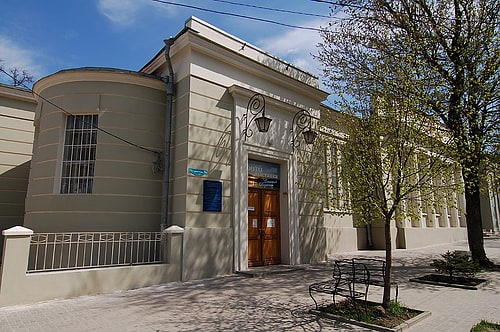
Also known as: Таганрогская городская публичная библиотека имени А. П. Чехова
Chekhov Library in Taganrog is the oldest library in the South of Russia.[35]